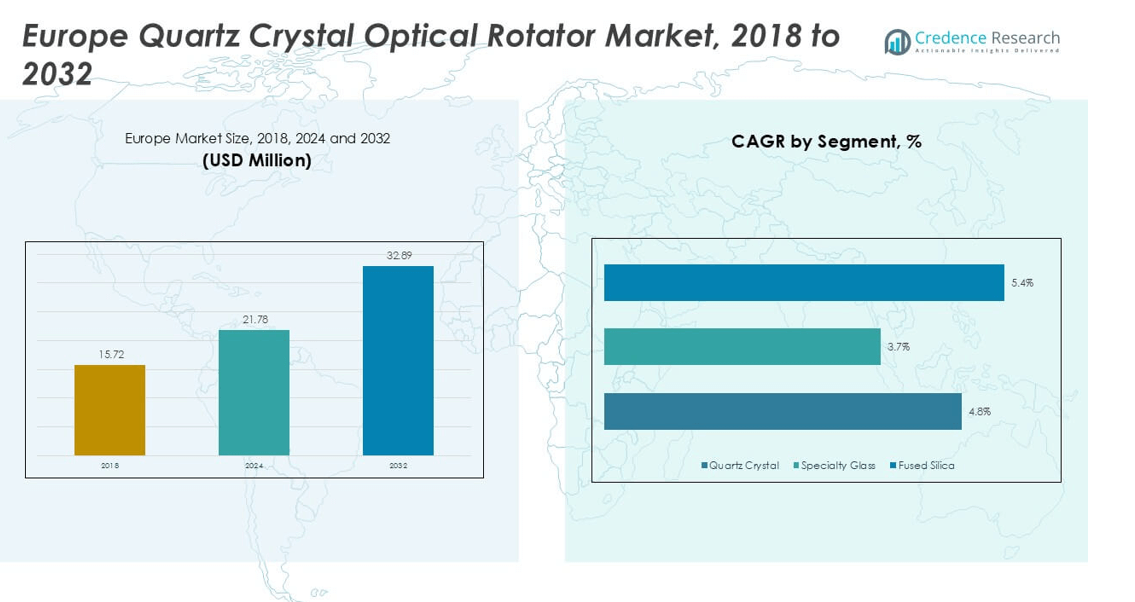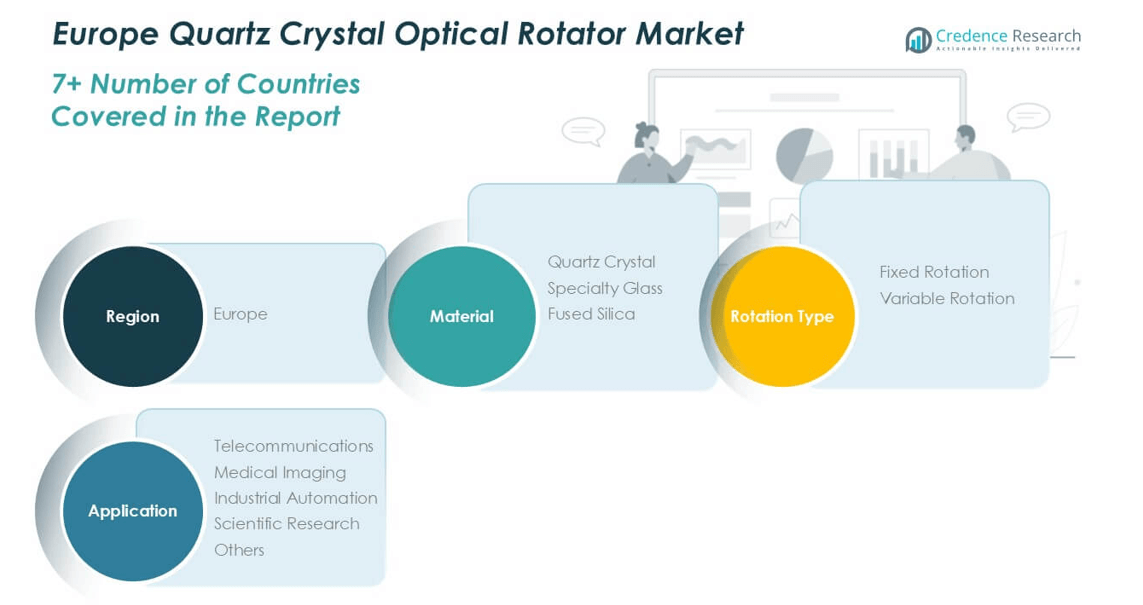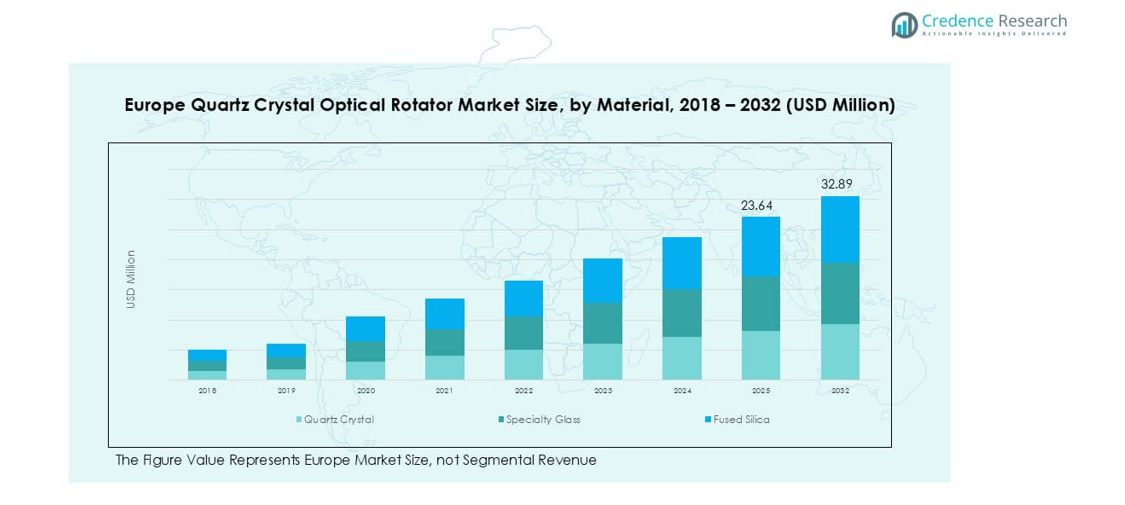Market overview
Europe Quartz Crystal Optical Rotator market size was valued at USD 15.72 million in 2018, reaching USD 21.78 million in 2024, and is anticipated to reach USD 32.89 million by 2032, at a CAGR of 4.8% during the forecast period.
| REPORT ATTRIBUTE |
DETAILS |
| Historical Period |
2020-2023 |
| Base Year |
2024 |
| Forecast Period |
2025-2032 |
| Europe Quartz Crystal Optical Rotator Market Size 2024 |
USD 21.78 million |
| Europe Quartz Crystal Optical Rotator Market, CAGR |
4.8% |
| Europe Quartz Crystal Optical Rotator Market Size 2032 |
USD 32.89 million |
The Europe quartz crystal optical rotator market is driven by leading players such as Crystal Innovations Ltd, OpticaQuartz Solutions LLC, Quartz Precision Instruments Inc, SpectraQuartz Corporation, and QuartzWave Technologies LLC, which focus on advanced product portfolios and tailored solutions for telecommunications, medical imaging, and industrial automation. These companies emphasize precision engineering and partnerships with research institutes to strengthen technological leadership. Regionally, Germany accounted for the largest share with over 20% in 2024, supported by strong industrial automation and healthcare infrastructure. The United Kingdom and France followed with 15% and 14% shares respectively, reflecting significant adoption in telecom and diagnostic imaging. This competitive and regionally diverse landscape ensures steady market growth across Europe.

Market Insights
- The Europe quartz crystal optical rotator market was valued at USD 21.78 million in 2024 and is projected to reach USD 32.89 million by 2032, growing at a CAGR of 4.8%.
- Key growth drivers include the expansion of 5G networks, rising demand for advanced medical imaging technologies, and growing use in industrial automation and scientific research, enhancing adoption across multiple applications.
- Market trends highlight increasing integration of rotators in next-generation fiber optic networks, along with material innovation in fused silica and specialty glass, supporting customization and niche applications.
- The competitive landscape features companies like Crystal Innovations Ltd, OpticaQuartz Solutions LLC, and SpectraQuartz Corporation, focusing on R&D partnerships and product reliability to maintain strong positions.
- Regionally, Germany led with 20% share in 2024, followed by the UK at 15% and France at 14%; by segment, telecommunications dominated with over 40% share, anchoring overall market expansion.
Access crucial information at unmatched prices!
Request your sample report today & start making informed decisions powered by Credence Research Inc.!
Download Sample
Market Segmentation Analysis:
By Material
Quartz crystal dominated the Europe quartz crystal optical rotator market in 2024, accounting for over 55% share. Its dominance is driven by superior optical activity, cost-effectiveness, and widespread adoption in precision optical systems. Quartz crystal is extensively used in telecommunications and medical imaging due to its stable birefringence and reliability under varied conditions. Specialty glass and fused silica segments are gaining traction, supported by demand in high-power laser optics and scientific research. However, quartz crystal remains the most influential sub-segment, supported by its scalability and consistent performance across industrial and research applications.
- For instance, PMOptics offers high-precision crystalline quartz rotators, but they are designed for specific, narrow wavelength ranges.
By Rotation Type
\
Fixed rotation optical rotators held the largest market share in 2024, contributing nearly 60% of total revenue in Europe. Their simple design, durability, and stable performance make them highly suitable for standardized telecommunications and medical imaging equipment. Widespread use in cost-sensitive applications strengthens their position compared to variable rotation types, which serve niche requirements in research and advanced laboratory setups. Fixed rotation remains dominant due to ease of integration in optical networks and automation systems, ensuring scalability for industrial deployments across the European market.
- For instance, Karl Lambrecht’s fixed quartz rotators come with rotation tolerances of ±0.06° at 1064 nm and ±0.7° at 347 nm.
By Application
Telecommunications emerged as the leading application segment in 2024, commanding over 40% share of the Europe quartz crystal optical rotator market. Growing deployment of high-speed fiber optic networks and 5G infrastructure drives strong demand for reliable optical components. Quartz crystal rotators ensure signal clarity and polarization control, making them critical in telecom systems. Medical imaging follows closely, driven by rising diagnostic investments in advanced imaging technologies. Industrial automation and scientific research further expand applications, but the telecommunications sector continues to anchor market growth with its broad adoption and continuous technological advancements.
Key Growth Driver
Expansion of Telecommunications Infrastructure
The rapid expansion of high-speed telecommunications networks is a major driver for the Europe quartz crystal optical rotator market. With countries across Europe accelerating 5G rollouts and fiber optic deployments, the need for efficient polarization control in optical signals is increasing significantly. Quartz crystal rotators play a vital role in ensuring signal stability, reducing interference, and supporting higher data transfer speeds. Germany, the U.K., and France are leading telecom upgrades, boosting demand across fixed and mobile broadband systems. The trend toward smart cities and IoT-based communication networks further reinforces growth, as advanced optical components become essential in meeting bandwidth and connectivity requirements.
- For instance, Edmund Optics offers a 90° crystalline quartz polarization rotator at 532 nm with rotational accuracy < 5 arcminutes and parallelism < 10 arcseconds.
Rising Demand in Medical Imaging Technologies
Medical imaging represents a critical growth driver, supported by Europe’s advanced healthcare infrastructure. Quartz crystal optical rotators are used in diagnostic equipment such as MRI and CT systems, where precise polarization control enhances imaging clarity. Western European nations, particularly Germany and France, invest heavily in upgrading diagnostic facilities, fueling adoption. Aging populations and the growing burden of chronic diseases are increasing demand for accurate, high-resolution imaging. The integration of optical rotators into advanced imaging systems improves reliability and diagnostic outcomes. With healthcare digitization and government spending on medical technologies, medical imaging continues to anchor steady demand for quartz-based optical solutions.
- For instance, Thorlabs’ Z-cut quartz polarization rotator (25.4 mm diameter) offers flatness of λ/10 at 633 nm and rotational tolerance ±0.5°.
Growth in Industrial Automation and Research Applications
Europe’s leadership in industrial automation and scientific research contributes significantly to market expansion. Quartz crystal optical rotators are increasingly integrated into precision instruments used in automation, robotics, and advanced manufacturing. Germany’s Industry 4.0 initiatives and France’s focus on high-tech industrial processes strengthen market demand. In addition, scientific research institutes across Northern and Western Europe utilize rotators in optical experiments, quantum optics, and advanced laser systems. Their high stability and consistent birefringence make quartz crystal rotators critical for laboratory applications. This dual demand from industrial and research segments ensures sustained market growth, positioning Europe as a strong hub for advanced optical technologies.

Key Trends & Opportunities
Integration with Next-Generation Fiber Optic Networks
One of the key trends shaping the Europe quartz crystal optical rotator market is its integration into next-generation fiber optic systems. With the rapid adoption of 5G and upcoming 6G initiatives, rotators are essential for enhancing polarization stability in high-bandwidth environments. Countries such as the U.K. and Germany are leading investments in advanced telecom infrastructure, where these components support seamless data transmission. Opportunities lie in expanding deployment across both fixed-line and mobile broadband systems. As Europe continues to modernize digital infrastructure, the use of rotators in fiber-to-the-home (FTTH) and large-scale data centers creates significant growth potential.
- For instance, PMOptics offers quartz rotators with rotation tolerance ±0.1° and parallelism < 30 arc seconds across 240–2100 nm, suitable for fiber link modules.
Advancements in Specialty Materials and Customization
Another emerging trend is the increasing demand for advanced optical materials and customized solutions. While quartz crystal remains dominant, growing applications in scientific research and medical imaging are driving interest in fused silica and specialty glass. Manufacturers are focusing on developing rotators with higher durability, improved resistance to environmental changes, and adaptability to niche applications. Custom-designed rotators tailored to specific wavelength ranges and industrial requirements present new opportunities for suppliers. This trend aligns with Europe’s emphasis on high-value, specialized optical systems, ensuring that innovation in materials and design continues to expand the market’s application base.
Key Challenges
High Manufacturing Costs and Complex Production Processes
The Europe quartz crystal optical rotator market faces challenges from high production costs and complex manufacturing processes. Precision in cutting, polishing, and aligning quartz crystals requires advanced equipment and skilled labor, driving up operational expenses. Small and medium-sized manufacturers often struggle to scale production economically, limiting competitiveness against larger players. In addition, the high cost of raw materials and quality assurance processes further add to pricing pressure. These cost barriers may hinder adoption in price-sensitive segments, particularly in Southern and Eastern Europe, where budget constraints can restrict investments in high-performance optical components.
Competition from Alternative Optical Technologies
Another challenge is growing competition from alternative optical technologies that offer cost-effective or simplified solutions. Advanced polarizers, waveplates, and digital polarization controllers are being increasingly adopted in telecommunications and research setups. These alternatives, while sometimes less precise, are often more affordable and easier to integrate into systems. For smaller applications, they provide viable substitutes, reducing the demand for quartz crystal rotators. Furthermore, continuous innovation in optical materials may pose long-term risks to quartz-based solutions. To sustain growth, manufacturers must emphasize product differentiation, higher performance features, and expanded applications that justify investment in quartz crystal technologies.
Regional Analysis
United Kingdom
The United Kingdom accounted for around 15% share of the Europe quartz crystal optical rotator market in 2024. Strong demand arises from its advanced telecommunications infrastructure, particularly investments in fiber optic networks and 5G deployment. The country’s healthcare sector also contributes, with leading hospitals and diagnostic centers adopting advanced medical imaging systems supported by optical components. Research institutions across the U.K. further drive niche applications in quantum optics and photonics. With continuous investments in digital transformation and innovation, the U.K. maintains a strong position as one of the leading adopters of optical rotator technologies in Europe.
France
France represented nearly 14% share of the Europe market in 2024, led by high adoption across telecommunications and medical imaging. Government-backed initiatives in healthcare modernization and diagnostic capacity expansion increase the demand for optical rotators in MRI and CT systems. France also maintains a strong industrial base, where automation and optical equipment integration support market growth. Research institutes focusing on advanced optics and laser systems further strengthen adoption. The country’s balanced contributions from healthcare, telecom, and industrial automation ensure steady market performance, positioning France as a major contributor to Europe’s overall optical component growth.
Germany
Germany dominated the Europe quartz crystal optical rotator market with over 20% share in 2024. Its leadership stems from a strong industrial automation sector, backed by Industry 4.0 initiatives that prioritize precision optical systems. The country’s robust telecommunications infrastructure and ongoing 5G expansions further increase adoption. Germany is also a leader in medical imaging technologies, supported by advanced hospitals and diagnostic centers. Academic and industrial research institutes frequently integrate rotators into photonics and laser systems, reinforcing market strength. Germany’s combination of industrial, healthcare, and research applications makes it the largest single national market in Europe.
Italy
Italy captured around 10% share of the Europe quartz crystal optical rotator market in 2024. The country’s growth is driven by rising investments in modernizing healthcare infrastructure, particularly diagnostic imaging facilities. Italy’s telecom operators are expanding fiber optic networks, which increases demand for optical polarization control components. Industrial automation in manufacturing hubs such as Northern Italy also contributes to steady adoption. While the country’s market is smaller compared to Western Europe, it benefits from a mix of healthcare and telecom-driven applications, positioning Italy as a growing regional player in advanced optical technology adoption.
Spain
Spain held nearly 9% share of the Europe quartz crystal optical rotator market in 2024, driven primarily by expanding telecommunications networks and digital infrastructure upgrades. The government’s push for broadband connectivity across urban and rural areas has strengthened demand for reliable optical components. Spain’s healthcare sector is gradually increasing investments in medical imaging systems, which also support adoption. Industrial automation remains a secondary but growing segment, particularly in automotive and manufacturing industries. With balanced growth across telecom and healthcare, Spain contributes steadily to the regional market, though at a smaller scale compared to Germany, France, and the U.K.
Russia
Russia accounted for about 12% share of the Europe quartz crystal optical rotator market in 2024. Demand is supported by investments in telecommunications modernization and industrial automation, especially within energy and manufacturing sectors. Russia also prioritizes domestic research programs in optics and photonics, creating niche opportunities for optical rotators. However, geopolitical and economic uncertainties pose challenges that can limit foreign collaborations and technology transfers. Despite these hurdles, Russia’s large industrial base and scientific research institutions sustain demand, ensuring the country remains a significant contributor to the overall European optical component market.
Rest of Europe
The Rest of Europe segment, including countries such as the Netherlands, Switzerland, Poland, and Nordic nations, collectively contributed around 20% share of the market in 2024. The Netherlands and Switzerland show strong adoption in telecommunications and data centers, while Nordic countries like Sweden and Finland emphasize advanced research and healthcare technologies. Poland and Eastern European markets are growing steadily with investments in telecom infrastructure modernization. This diverse regional group reflects a combination of developed and emerging markets, ensuring both steady growth and new opportunities for quartz crystal optical rotators across Europe’s broader landscape.

Market Segmentations:
By Material
- Quartz Crystal
- Specialty Glass
- Fused Silica
By Rotation Type
- Fixed Rotation
- Variable Rotation
By Application
- Telecommunications
- Medical Imaging
- Industrial Automation
- Scientific Research
- Others
By Geography
- United Kingdom
- France
- Germany
- Italy
- Spain
- Russia
- Rest of Europe
Competitive Landscape
The competitive landscape of the Europe quartz crystal optical rotator market is characterized by a mix of established manufacturers and specialized optical technology providers, each focusing on innovation, precision engineering, and application-specific solutions. Companies such as Crystal Innovations Ltd, OpticaQuartz Solutions LLC, and Quartz Precision Instruments Inc maintain strong market positions through their extensive product portfolios and integration into telecommunications and medical imaging systems. SpectraQuartz Corporation and QuartzWave Technologies LLC emphasize advanced designs tailored for industrial automation and scientific research, while Visionary Photonics Inc and Optical Quartz Ltd strengthen the market with customized high-performance solutions. Competition centers on technological advancements, product reliability, and the ability to meet the stringent demands of European telecom and healthcare industries. Strategic collaborations with research institutes, along with investments in material innovation like fused silica and specialty glass, are shaping differentiation strategies. Overall, the market remains highly competitive, with innovation and precision manufacturing serving as the core drivers of leadership.
Shape Your Report to Specific Countries or Regions & Enjoy 30% Off!
Key Player Analysis
- Crystal Innovations Ltd
- OpticaQuartz Solutions LLC
- Optical Engineering Dynamics LLC
- Quartz Precision Instruments Inc
- SpectraQuartz Corporation
- QuartzWave Technologies LLC
- Spectral Optics Corp
- Visionary Photonics Inc
- Optical Quartz Ltd
- Deltronic Crystal Industries
Recent Developments
- In June 2025, major showcasing of advanced photonics and optical systems occurred at the Laser World of Photonics event, featuring innovations relevant to high-precision optical manipulation.
Report Coverage
The research report offers an in-depth analysis based on Material, Rotation Type, Application and Geography. It details leading market players, providing an overview of their business, product offerings, investments, revenue streams, and key applications. Additionally, the report includes insights into the competitive environment, SWOT analysis, current market trends, as well as the primary drivers and constraints. Furthermore, it discusses various factors that have driven market expansion in recent years. The report also explores market dynamics, regulatory scenarios, and technological advancements that are shaping the industry. It assesses the impact of external factors and global economic changes on market growth. Lastly, it provides strategic recommendations for new entrants and established companies to navigate the complexities of the market.
Future Outlook
- The market will see steady growth driven by advanced telecommunications adoption across Europe.
- Increasing deployment of 5G and future 6G networks will boost demand for optical rotators.
- Medical imaging applications will expand with greater investment in diagnostic technologies.
- Industrial automation will continue to adopt optical rotators for precision equipment and robotics.
- Scientific research will strengthen usage in photonics, quantum optics, and advanced laser systems.
- Material innovation in fused silica and specialty glass will create new opportunities.
- Customization of rotators for niche applications will become a key differentiator.
- Competition will intensify as regional players invest in R&D partnerships.
- Western Europe will remain the dominant region due to its industrial and healthcare base.
- Overall, the market will advance with a balance of innovation, regional demand, and technology integration.










